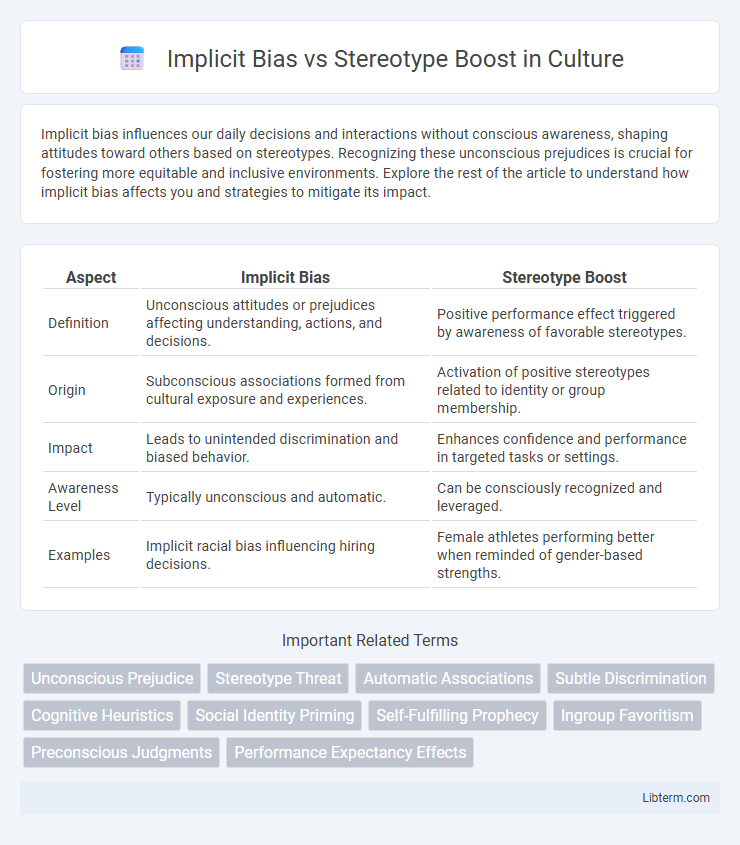Implicit bias influences our daily decisions and interactions without conscious awareness, shaping attitudes toward others based on stereotypes. Recognizing these unconscious prejudices is crucial for fostering more equitable and inclusive environments. Explore the rest of the article to understand how implicit bias affects you and strategies to mitigate its impact.
Table of Comparison
| Aspect | Implicit Bias | Stereotype Boost |
|---|---|---|
| Definition | Unconscious attitudes or prejudices affecting understanding, actions, and decisions. | Positive performance effect triggered by awareness of favorable stereotypes. |
| Origin | Subconscious associations formed from cultural exposure and experiences. | Activation of positive stereotypes related to identity or group membership. |
| Impact | Leads to unintended discrimination and biased behavior. | Enhances confidence and performance in targeted tasks or settings. |
| Awareness Level | Typically unconscious and automatic. | Can be consciously recognized and leveraged. |
| Examples | Implicit racial bias influencing hiring decisions. | Female athletes performing better when reminded of gender-based strengths. |
Understanding Implicit Bias: Definition and Origins
Implicit bias refers to unconscious attitudes or stereotypes that affect understanding, actions, and decisions without intentional awareness. Rooted in socialization, cultural messaging, and evolutionary psychology, these biases originate from automatic cognitive processes that help individuals categorize information rapidly. Understanding implicit bias involves recognizing its pervasive influence on behavior, often distinct from explicit beliefs, and its role in perpetuating systemic inequalities.
What Is Stereotype Boost?
Stereotype boost refers to the positive impact on an individual's performance when they are aware of a favorable stereotype about their social group. This psychological effect enhances confidence and motivation, leading to improved outcomes in tasks or situations aligned with the stereotype. Understanding stereotype boost helps in recognizing how social expectations influence behavior alongside implicit bias, which generally involves unconscious negative associations.
Key Differences: Implicit Bias vs Stereotype Boost
Implicit bias refers to unconscious attitudes or beliefs that affect understanding, actions, and decisions in an involuntary manner, often leading to prejudiced behavior without conscious awareness. Stereotype boost, conversely, occurs when positive stereotypes enhance an individual's performance or confidence in a specific domain, leveraging societal expectations as motivation. The key difference lies in implicit bias generally causing negative or limiting outcomes, whereas stereotype boost results in improved performance due to positive stereotype activation.
Psychological Mechanisms Behind Implicit Bias
Implicit bias operates through automatic, unconscious associations formed by repeated social conditioning, influencing attitudes and behaviors without deliberate awareness. These biases activate neural pathways in the amygdala and prefrontal cortex, causing swift emotional and cognitive responses to perceived social categories. Unlike stereotype boost, which enhances performance based on positive group stereotypes, implicit bias perpetuates prejudices by embedding ingrained, often negative, evaluations that affect decision-making and social interactions.
How Stereotype Boost Influences Performance
Stereotype boost enhances performance by activating positive expectations linked to a person's group identity, which increases motivation and confidence during tasks. This phenomenon contrasts with implicit bias, where unconscious negative associations hinder performance. Research shows individuals experiencing stereotype boost often outperform peers by leveraging societal stereotypes favorably in academic and professional settings.
Real-World Examples of Implicit Bias
Implicit bias influences behavior unconsciously, as seen in hiring processes where candidates with identical resumes receive different evaluations based on perceived gender or ethnicity. In healthcare, implicit bias can lead to disparities in pain management, with minority patients often undertreated compared to white patients. These real-world examples highlight how implicit biases subtly shape decisions and perpetuate inequality despite conscious intentions.
Case Studies: Stereotype Boost in Action
Case studies on stereotype boost reveal how positive stereotypes enhance performance in specific groups; for example, research demonstrates that Asian American students often excel in math due to cultural beliefs emphasizing academic success. Another study showed that women performed better on math tests when told that their gender typically excels in the task, illustrating the counteracting effect of stereotype boost compared to stereotype threat. These findings underscore how leveraging positive stereotypes can improve cognitive performance and reduce the negative impact of implicit bias.
The Impact on Workplace Dynamics
Implicit bias subtly influences workplace decisions by unconsciously shaping attitudes toward colleagues based on social group associations, often leading to unequal opportunities and microaggressions. Stereotype boost, conversely, enhances an individual's performance when positive stereotypes about their group are activated, potentially skewing task outcomes and evaluations. These contrasting effects complicate workplace dynamics by reinforcing inequities and impacting team cohesion, productivity, and inclusivity efforts.
Strategies for Addressing Implicit Bias and Stereotype Boost
Addressing implicit bias requires structured interventions such as mindfulness training, exposure to counter-stereotypical examples, and fostering inclusive environments that promote self-awareness and empathy. Strategies for mitigating stereotype boost involve reframing tasks to emphasize individual capabilities, creating positive role models, and implementing affirmations that reinforce confidence and reduce anxiety associated with stereotype threat. Combining evidence-based approaches from social psychology and organizational behavior can effectively reduce the impact of implicit bias and stereotype boost in diverse settings.
Future Directions: Reducing Bias and Harnessing Positive Effects
Future directions in addressing implicit bias emphasize developing targeted interventions to reduce unconscious prejudices through training programs and neurofeedback techniques. Research explores harnessing stereotype boost by strategically activating positive stereotypes to improve performance in education and workplace settings. Integrating artificial intelligence tools offers promising avenues for real-time bias detection and fostering inclusive environments.
Implicit Bias Infographic

 libterm.com
libterm.com